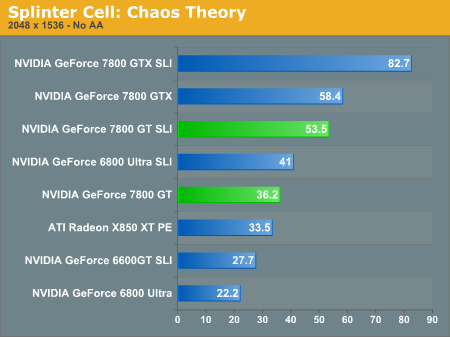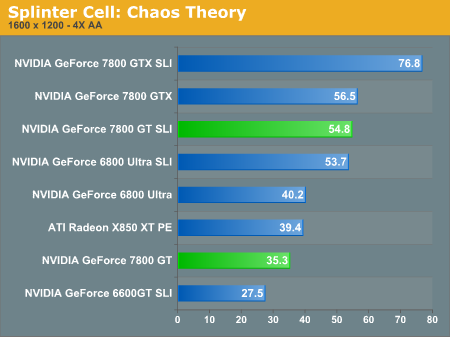NVIDIA GeForce 7800 GT: Rounding Out The High End
by Derek Wilson & Josh Venning on August 11, 2005 12:15 PM EST- Posted in
- GPUs
Splinter Cell: Chaos Theory Performance
Splinter Cell: Chaos Theory has the capacity to bring almost any card to its knees when you enable the HDR rendering modes. SM2.0 support has been added via the latest patch, allowing ATI cards to also support the HDR rendering modes. We aren't looking at HDR rendering here, as it's still not an apples-to-apples comparison, but ATI owners can at least get improved graphics now.


In our G70 review, we saw that the 7800 GTX was able to outperform the 6800 Ultra in SLI mode in all tested resolutions. Granted, it was only by a small margin in some cases, but it's impressive nonetheless. Even more surprising is that at present, a single 7800 GTX outperforms even the 7800 GT SLI configuration in the three tested resolutions. Enabling HDR rendering would of course change the results quite a bit.
As the numbers show, the 7800 GT is no match for the 6800U SLI in this game. At 1600x1200, the 7800 GT gets 51.7 fps, as opposed to the 6800Us 40.2 (a 28.6% increase). The SLI setup gains another 24 frames over the GT however, for an 89% increase. At 2048x1536, the 6800U gets 22.2 fps, while the 7800 GT gets 36.2 (a 63% increase), and the 6800U SLI gets 41 fps (an 85% increase).
Taking into consideration the much higher gains in performance with the 6800 Ultra in SLI mode, it looks to be a promising alternative to the single 7800 GT if you have the means. While you may need to upgrade your power supply and possibly your motherboard to fit two 6800 Ultras, this may not cost as much as you'd expect, especially considering that prices for these things will likely be falling soon. Depending on how much it costs for a particular setup, the 7800 GTX may be a better option.










77 Comments
View All Comments
bob661 - Thursday, August 11, 2005 - link
Forgot all about this. Thanks.
jkostans - Thursday, August 11, 2005 - link
The 9800 pro had to be the best budget investment in all of video card history (as far as I can remember anyways). The price for the 128MB version quickly dropped to below $200 and it was pretty much the top performing card on the market for that price. Now its impossible to find a sub $200 offering that will last for more than 6 months.bob661 - Thursday, August 11, 2005 - link
Same here, sort of. I would LOVE to have a mid range card based on this tech. Running cooler and performing MUCH better than my current setup.
neogodless - Thursday, August 11, 2005 - link
I think what the two of you are missing is that the Geforce 6 series is basically the same technology. This pushes the 6800GT a little closer to mainstream, as it can currently be had for around $250-300, and it will probably drop in the next few months to the $200 level, which is about where it could be considered mainstream (and probably about what you paid for your 6600GT. Any new "mainstream" 7xxx releases would simply overlap current 6xxx parts. If the 7xxx series showed more of a technological difference, then this sort of thing would make more sense. If you go to Nvidia's home page, you'll see their "power of 3" marketing push, and see the list of products that all share this same technology.Lonyo - Thursday, August 11, 2005 - link
Yup.The original request was for "Like a 12-16 pipe/ 256-bit 7600 GT"
Err, the 6800, 6800GT are 12 and 16 pipe, 256bit SM3 cards.
How would a 7600GT type part be ANY different than what we already have, except for being cooler/cheaper to make?
In terms of performance, it's just a case of the 6800 dropping down to cheaper prices.
And as I said in the forums:
"Lower end redesigned parts to replace the 6xxx series would probably use 11nm tech, which would lead to smaller dies, and lower power consumption, reducing heat in the end, and reducing cost to make the die in the first place, making it a better deal for both consumers and nVidia, although transitioning the NV40 to 0.11 might not be worth the hassle."
ie: there's already a current part fitting the niche you want a brand new part for, and the probable only changes would be a transition to a smaller process, and a dropping of the price.
bob661 - Thursday, August 11, 2005 - link
Like I said, I find the cooler/faster combination VERY attractive. I don't care about the 6800GT as it will be warmer/slower than a "7600GT".PrinceGaz - Friday, August 12, 2005 - link
While the 6800GT would be warmer than a hypothetical 16-pipe 7600GT, it would not be slower. On the contrary, the 6800GT would probably be faster. Why? Because it has a 256-bit memory-bus, and in all probability the 7600 series would have a 128-bit bus.The 6800 and 7800 series are designed as high-end parts and for that they need the 256-bit bus to allow satisfactory performance at the extreme resolutions with AA that high-end users demand. The 6600 and possible 7600 are designed as mid-range parts and they do not need to be able to run at such high resolutions with AA, therefore they can make do with a 128-bit bus as memory-bandwidth is not so important at medium resolutions. The 128-bit bus lowers the cost of manufacturing the core, and also the card's circuit board as it is much simplified, and provides a clear distinction between the mid-range and high-end parts.
Do you really think they'd release a 16-pipe 256-bit 7600GT, when the 7800GT is "only" a 20-pipe card? The performance gap would be too narrow. A 12-pipe 256-bit 6600GT would be a possibility, but it would make a lot less sense than a 16-pipe 128-bit 6600GT.
If you want a 16-pipe 256-bit card, just go out and buy a 6800GT. It's every bit as good as the 16-pipe 256-bit 7600GT you want but which will never be released.
PrinceGaz - Friday, August 12, 2005 - link
Ooops the third paragraph should read "Do you really think they'd release a 16-pipe 256-bit 7600GT, when the 7800GT is "only" a 20-pipe card? The performance gap would be too narrow. A 12-pipe 256-bit 7600GT would be a possibility, but it would make a lot less sense than a 16-pipe 128-bit 7600GT."I started calling the 7600GT the 6600GT.
bob661 - Thursday, August 11, 2005 - link
It may be basically the same tech but my 6600GT will never perform like a "7600GT" would. And that's basically what I'm interested in. I don't see why a 7600GT part couldn't be sold at the $200-$220 price point. I'd buy it.neogodless - Thursday, August 11, 2005 - link
Likewise your 6600GT won't perform like a 6800GT... which would perform the same as a 7600GT... the 6800GT will be sold in the $200-$220 price point within six months, and probably sooner.What I might find exciting... would be if ATI actually gets their new card out... and has new mainstream parts (available to buy) that drive down the prices of the X800/X850 and Geforce 6800GT even more, and maybe introduce some new technology, too.
Has anyone heard anything about naming of the new ATI cards? Are they finally ready to give up the Radeon name... or their new X naming? If they went with X900 for the new flagship, would they be able to release new mainstream parts, since there would be nothing to name them?!